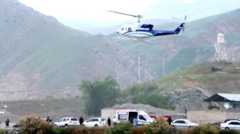With updates from BBC Persian and Chief International Correspondent Lyse Doucet.
Summary
- Iran state TV says there is “no sign of life” at the crash site of a helicopter that was carrying President Ebrahim Raisi and Iranian Foreign Minister Hossein Amir-Abdollahian
- Reports say the helicopter – one of three travelling in a convoy – made a “hard landing” on Sunday after it got into difficulties in heavy fog in the north of the country
- Raisi was heading to the city of Tabriz, in the north west of Iran, after returning from an Iran-Azerbaijan border area, according to local media
- The incident sparked a massive search operation that was hampered by bad weather conditions
- Watch live BBC News coverage by pressing the play button at the top of this page
-
‘No sign of life’ at Raisi helicopter wreck site – state TV
There is “no sign” of life coming from President Ebrahim Raisi’s helicopter, state TV says.
Reuters has also reported that the helicopter was “completely burned” in the crash, citing an Iranian official.
“President Raisi’s helicopter was completely burned in the crash… unfortunately, all passengers are feared dead,” the official said.

Rescuers will reach helicopter ‘in a few minutes’ – state media
Rescuers will reach the helicopter location in “a few minutes”, the head of Iran’s Red Crescent Society Pirhossein Kolivand has told state media.
He said that they were approximately 2km from where the hard landing is thought to have taken place.
No clarity, but a familiar stage being set
Bahman Kalbasi
BBC Persian in New York
For those of us who lived in Iran in the late 1980s, the days leading up to the official announcement of the death of Ayatollah Khomeini, the founder of Islamic Republic, and the images of the funeral that followed are etched into our memory.
The Islamic Republic’s media apparatus prepared the ground by asking people to pray for the leader. Loyalists responded by gathering in mosques overnight. Finally at the crack of dawn the mood in those mosques shifted from praying for his health to mourning his loss. And then came the state broadcasting announcement at 07:00.
State media reports and the tone of the current supreme leader Ayatollah Ali Khamenei’s speech in the last hours appear to be setting a similar stage – asking the public to pray, loyalists gathering at a square in Tehran to do so, and reassurances that the day-to-day function of the country’s affairs will not be impacted.
While we await clarity over what happened at the crash site, reading the tea leaves points to the regime preparing this familiar playbook.
Iran’s poor aviation safety record.
-
For those of us who lived in Iran in the late 1980s, the days leading up to the official announcement of the death of Ayatollah Khomeini, the founder of Islamic Republic, and the images of the funeral that followed are etched into our memory.
The Islamic Republic’s media apparatus prepared the ground by asking people to pray for the leader. Loyalists responded by gathering in mosques overnight. Finally at the crack of dawn the mood in those mosques shifted from praying for his health to mourning his loss. And then came the state broadcasting announcement at 07:00.
State media reports and the tone of the current supreme leader Ayatollah Ali Khamenei’s speech in the last hours appear to be setting a similar stage – asking the public to pray, loyalists gathering at a square in Tehran to do so, and reassurances that the day-to-day function of the country’s affairs will not be impacted.
While we await clarity over what happened at the crash site, reading the tea leaves points to the regime preparing this familiar playbook.
-
Iran’s poor aviation safety record
Siavash Ardalan
BBC Persian senior reporter
 Copyright: Reuters
Copyright: ReutersImage caption: President Raisi took off earlier in a Bell 212 helicopter The cause of the helicopter crash is not yet known – but Iran has a poor air transport safety record.
This is at least partly the result of decades of US sanctions, which have severely weakened its aerial fleet.
President Raisi was on board a Bell 212 helicopter, state news agencies said. The model was made in the US and could not have been sold to Iran since the 1979 revolution.
Previous ministers of defence and transport, as well as commanders of Iran’s ground and air armed forces, have died in plane or helicopter crashes.
When reformers led Iran’s government, they aimed to modernise the country’s fleet of aircraft by negotiating a deal with the West that would see sanctions lifted in return for limiting Iran’s sensitive nuclear activities and allowing in international inspectors
However, these efforts stalled when President Donald Trump withdrew from the deal and reimposed sanctions.
Reformers were subsequently opposed and mocked by hardliners, who insisted that Iran could rely on its domestic industries and foreign allies to improve aviation safety.
Watch: Turkish drone’s route in search for Raisi
Video content
Video caption: Watch: Turkey drone’s live route in search for Iran’s President Raisi Earlier we reported that a Turkish drone that joined the search for Raisi’s helicopter had identified a heat source.
The Bayraktar Akinci drone’s route over rugged topography in north-western Iran has been visible on flight-tracking websites.
-



